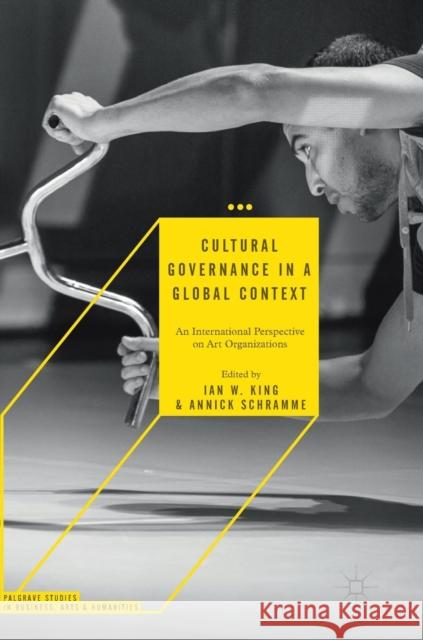Cultural Governance in a Global Context: An International Perspective on Art Organizations » książka



Cultural Governance in a Global Context: An International Perspective on Art Organizations
ISBN-13: 9783319988597 / Angielski / Twarda / 2019 / 343 str.
Cultural Governance in a Global Context: An International Perspective on Art Organizations
ISBN-13: 9783319988597 / Angielski / Twarda / 2019 / 343 str.
(netto: 575,06 VAT: 5%)
Najniższa cena z 30 dni: 578,30
ok. 22 dni roboczych
Dostawa w 2026 r.
Darmowa dostawa!
This original book explores the character of cultural governance of arts and cultural institutions in eight countries across five continents.
1. Introduction (Ian W. King and Annick Schramme)
1.2 Corporate Governance.
1.3 What is Cultural Governance?
1.4 General Principles of Governance
1.5 Methodology and Empirical Journeys
1.6 Concluding comments and Model for development
2. Ethiopia (Karan Khurana)
2.1. Introduction
2.2. The Cultural dimensions of Ethiopia
2.3. The role of Governments in promotion of Culture
2.4. The Problems of the Cultural sector in Ethiopia.
2.5. Cultural Governance and Its relevance to Ethiopia.
2.6. Conclusions and the Future of Arts and Culture.
3. Taiwan (Ching-Ju Cheng, Debbie Chieh-Yu Lee and Jerry Lui)
3.1. Introduction
3.2. Characteristics and Strengths of Art and Cultural Sector in Taiwan
3.3. Cultural Governance in Taiwan
3.4. Five Principles of Good Governance in Taiwan
3.5. Results of the Questionnaires in Taiwan
3.6. Conclusion
4. China/Hong Kong (Ding Yu and Ian W. King)
4.1. Introduction
4.2. Formation of the Basic Fine Arts System Since 1949
4.3. The Reconstruction and Reform of Arts Institutions in the New Era
4.4. The Transformation of Arts System in the Market Economy of the 1990s
4.5. The Emergence of Art Management in the New Century and the Construction of Future Art System.
4.6. Hong Kong – new beginnings or burdens from the past?
4.7. Discussion and Concluding Comments
5. India (Archana Suranna and Benoy Thoompunkal)
5.1. Introduction
5.2. Value of Arts and Culture to people and society of India
5.3. Prevention and Promotion of Indian Art & Culture
5.4. Cultural Governance in Indian System
5.5. Traditional to Technology Culture
5.6. Patrons, Practitioners and Managers- Private and Public Sector
5.7. Principles of Cultural Governance in Indian Context
5.8. Boards and Governing Councils of Cultural Organizations
5.9. The value and contribution of (internal and external) stakeholders
5.10. Funding of Indian Cultural organizations.
5.11. Fund generation by Cultural Institutions;
5.12. Finance and budgeting
6. Australia (John Smithies, Raji Uppal)
6.1. Introducing Australia6.2. The contemporary setting
6.3. “Cultural policy” in Australia and the complementarity between
nation, region and local level.
6.4. 'Cultural governance' in Australia
6.5. The ‘five principles’ in Australia
6.6. Cultural Development Network – current trends and concluding
comments
7. South Africa (Avril Joffe, Munyaradzi Chatikobo, Annabell Lebethe , Johanna Mavhungu)
7.1. Introduction
7.2. South Africa and the arts and culture sector
7.3. The relevance and significance of the 5 principles of cultural
governance
7.4. The values and contribution of stakeholders.
7.5. Additional Principles of Cultural Governance in the South African
Context
7.6. Conclusion
8. Brazil (Renata Berman)
8.1. Introduction
8.2. The place of Arts and Culture in Brazil.
8.3. Culture and the private sector
8.4. Providing context: Brazil
8.5. Background to cultural governance.
8.6. Discussion
9. Serbia (Milena Dragićević Šešić and Nina Mihaljinac)
9.1. Introduction
9.2. Cultural sector: strengths and weaknesses
9.3. Methodology of the research
9.4. Contradictory paths of cultural governance: analysis of the research
results
9.5. Conclusions: Managing routine or managing quality: Cultural
governance challenge.
10. USA (Sherburne Laughlin)
10.1. Introduction
10.2. The United States Context
10.3. Philanthropy in the United States
10.4. Nonprofit and Arts and Culture Boards in the United States
10.5. The 5 Principles and the United States Boards
10.6. The Future of U.S. Arts and Culture Boards
10.7. Conclusion
11. Conclusion (Ian W. King and Annick Schramme)
11.1. Introduction
11.2. General Observations
11.3. Towards a New Model
11.4. Discussion
11.5. Conclusion
Ian W. King is Professor of Aesthetics and Management at the University of the Arts, London, UK and the London College of Fashion. He is also visiting professor at the universities of Antwerp, Belgium; Karlshochschule, Germany; RMIT, Australia and the Shanghai Institute for Visual Arts, China. He is chair of the college research degrees committee and international coordinator of the International Fashion Colloquia series.
Annick Schramme is Professor and Academic Director of the Masters in Cultural Management at the University of Antwerp, Belgium. She also leads the Competence Center Creative Industries at the Antwerp Management School. She has published on arts policy, international cultural policy, heritage, cultural governance, leadership, cultural entrepreneurship, and the creative city etc. From 2004-13 she was advisor-expert to the Vice-Mayor for Culture and Tourism of the City of Antwerp.
This original book explores the character of cultural governance of arts and cultural institutions in eight countries across five continents. Examining strategy and decision-making at an organisational level, this is the first empirical contribution on cultural policy and management, revealing how it is applied across the globe in otherwise unexplored countries. Concerned with the assumption that ‘one-size fits all’, the chapter authors analyse how cultural governance is managed within arts organizations in a range of countries to assess whether some locations are trying to apply unsuitable models. The chapters aim to discover and assess new practices to benefit the understanding of cultural governance and the arts sector which have as yet been excluded from the literature. As a collection of local accounts, this book offers a broad and rich perspective on managing cultural governance around the world.
1997-2025 DolnySlask.com Agencja Internetowa
KrainaKsiazek.PL - Księgarnia Internetowa









